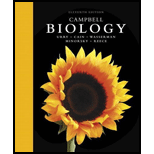
Campbell Biology (11th Edition)
11th Edition
ISBN: 9780134093413
Author: Lisa A. Urry, Michael L. Cain, Steven A. Wasserman, Peter V. Minorsky, Jane B. Reece
Publisher: PEARSON
expand_more
expand_more
format_list_bulleted
Concept explainers
Textbook Question
Chapter 8.3, Problem 1CC
How does ATP typically transfer energy from an exergonic to an endergonic reaction in the cell?
Expert Solution & Answer
Want to see the full answer?
Check out a sample textbook solution
Students have asked these similar questions
What is ATP? What structure in the cell where ATP stored?
What part of Complex V performs ATP synthesis?
Which of the following among A- D is incorrect regarding the proton motive force and ATP synthase (ATPase)?
A) O The F1 subunit of the ATPase binds ADP and phosphate, forms ATP, and then releases ATP
B) O Increasıng the difference in pH across the membrane of a bacterial cell would likely increase its proton motive force.
O O The ATPase is a molecular motor that moves as protons flow through it.
D) O Increasing the negative charge inside a bacterial cell would likely increase the proton motive force.
E) O All of A- D is correct.
Chapter 8 Solutions
Campbell Biology (11th Edition)
Ch. 8.1 - MAKE CONNECTIONS How does the second law of...Ch. 8.1 - Describe the forms of energy found in an apple as...Ch. 8.1 - WHAT IF? If you place a teaspoon of sugar in the...Ch. 8.2 - Cellular respiration uses glucose and oxygen,...Ch. 8.2 - VISUAL SKILLS How would the processes of...Ch. 8.2 - WHAT IF? Some nighttime partygoers wear glow-in-...Ch. 8.3 - How does ATP typically transfer energy from an...Ch. 8.3 - Prob. 2CCCh. 8.3 - MAKE CONNECTIONS Does Figure 8.11a show passive...Ch. 8.4 - Many spontaneous reactions occur very slowly. Why...
Ch. 8.4 - Prob. 2CCCh. 8.4 - WHAT IF? Malonate is an inhibitor of the enzyme...Ch. 8.4 - Prob. 4CCCh. 8.5 - How do an activator and an inhibitor have...Ch. 8.5 - Prob. 2CCCh. 8 - Explain how the highly ordered structure of a cell...Ch. 8 - Explain the meaning of each component in the...Ch. 8 - Describe the ATP cycle: How is ATP used and...Ch. 8 - How do both activation energy barriers and enzymes...Ch. 8 - Prob. 8.5CRCh. 8 - Choose the pair of terms that correctly completes...Ch. 8 - Prob. 2TYUCh. 8 - Which of the following metabolic processes can...Ch. 8 - Prob. 4TYUCh. 8 - Some bacteria art metabolically active in hot...Ch. 8 - If an enzyme is added to a solution where its...Ch. 8 - Prob. 7TYUCh. 8 - EVOLUTION CONNECTION Some people argue that...Ch. 8 - Prob. 9TYUCh. 8 - WRITE ABOUT A THEME: ENERGY AND MATTER Life...Ch. 8 - Prob. 11TYU
Additional Science Textbook Solutions
Find more solutions based on key concepts
Why do scientists think that all forms of life on earth have a common origin?
Genetics: From Genes to Genomes, 5th edition
Nursing Student with Neuropathic Pain
Tamara Costa broke her right tibia and has undergone two separate surger...
Human Anatomy & Physiology (11th Edition)
Describe the evolution of mammals, tracing their synapsid lineage from early amniote ancestors to true mammals....
Loose Leaf For Integrated Principles Of Zoology
Describe Mendels conclusions about how traits are passed from generation to generation.
Concepts of Genetics (11th Edition)
Knowledge Booster
Learn more about
Need a deep-dive on the concept behind this application? Look no further. Learn more about this topic, biology and related others by exploring similar questions and additional content below.Similar questions
- What Are the Complex Equilibria Involvedin ATP Hydrolysis?arrow_forwardWhat is the compound that is phosphorylated for ATP formation? What is the resulting compound when ATP liberates energy?arrow_forwardAs electrons move from Complex I & II to Complex IV, H+ ions accumulate in the intermembrane space. Describe how these ions are then used to generate ATP using the following terms: ATP synthase, ADP, ATP, electrochemical gradient, chemiosmosis, intermembrane space, matrix.arrow_forward
- What is the total output of ATP, aerobically, in prokaryotic cells and eukaryotic cells?arrow_forwardWhat does it mean to say that ATP is the “energy currency” of the cell? b) What type of energy does ATP represent? c) Where/what part of the molecule is energized? d) What is meant by the ATP cycle?arrow_forwardIn which reaction does an intermediate pathway become oxidized? Which step consists of a phosphorylation reaction in which ATP is the phosphate source?arrow_forward
arrow_back_ios
SEE MORE QUESTIONS
arrow_forward_ios
Recommended textbooks for you
 Concepts of BiologyBiologyISBN:9781938168116Author:Samantha Fowler, Rebecca Roush, James WisePublisher:OpenStax College
Concepts of BiologyBiologyISBN:9781938168116Author:Samantha Fowler, Rebecca Roush, James WisePublisher:OpenStax College

Concepts of Biology
Biology
ISBN:9781938168116
Author:Samantha Fowler, Rebecca Roush, James Wise
Publisher:OpenStax College
Anaerobic Respiration; Author: Bozeman Science;https://www.youtube.com/watch?v=cDC29iBxb3w;License: Standard YouTube License, CC-BY